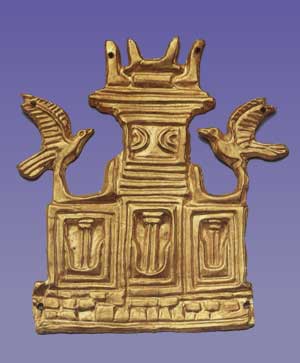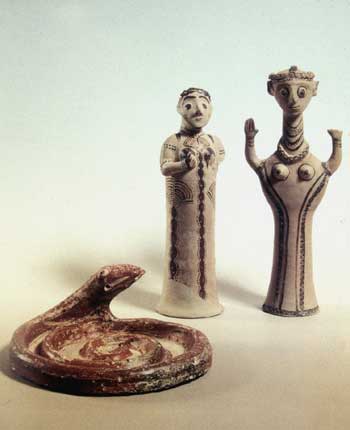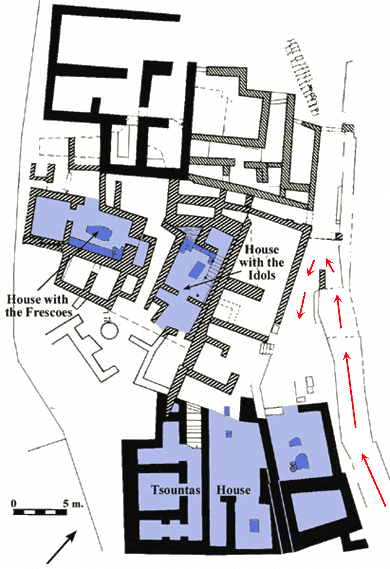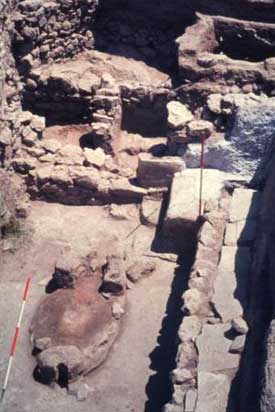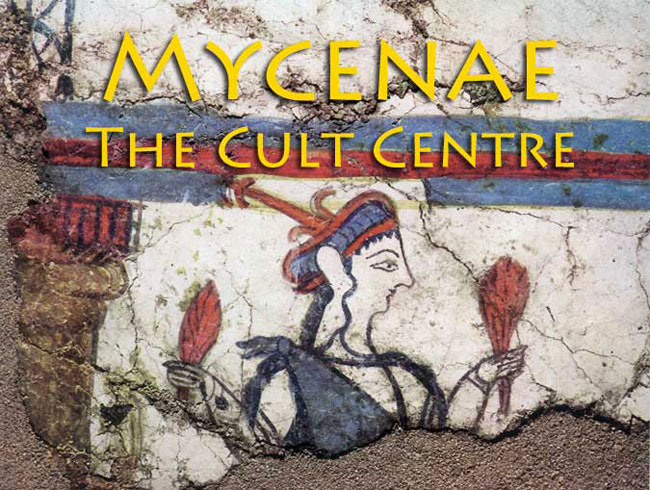
Mycenaean Religion
Physical evidence for Mycenaean religion and cult practice is fairly abundant for the Late Helladic period. There are the remains of the shrines themselves along with figurines, sacred objects, fresco fragments and seal impressions with scenes of cult activity. Unfortunately, what is missing is contemporary written evidence—apart from catalogues of deities and offerings found at Knossos 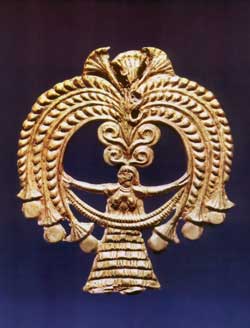 and Pylos. Modern interpretations tend to be based on later Greek mythology and cosmology—in the assumption that they have absorbed a lot of earlier ideas—as well as the beliefs and practices of other Indo European speaking peoples.
and Pylos. Modern interpretations tend to be based on later Greek mythology and cosmology—in the assumption that they have absorbed a lot of earlier ideas—as well as the beliefs and practices of other Indo European speaking peoples.
By the middle of the fifteenth century BC, Greeks from the mainland had made themselves masters of Crete and ruled the island from the palace at Knossos. Most of the material that has survived, mainly from tombs, was the product of Minoan workshops and a good deal of it probably arrived as booty. Indo-Europeans tend to be tolerant of other peoples deities are very respectful to local gods and goddesses when they encounter them, incorporating them into their own systems quite readily. In the eastern Mediterranean, they entered a region that had been dominated for thousands of years by the cult of the great mother goddess. She is associated with mountaintops, springs, caves and other permanent features of the landscape. The male side of the equation was represented by a the power of the bull or by the young god. The general opinion is that the bull is a rather obvious symbol of male potency, seeding the womb of the earth. In the later mythology, Zeus appears in Crete in the guise of a bull and fathers the Minotaur, who is half man and half bull, on the Minoan queen Pasiphaë. The young god, who is killed in the mythology (Adonis, for example), represents the harvesting of the crops or the culling of the young animals.
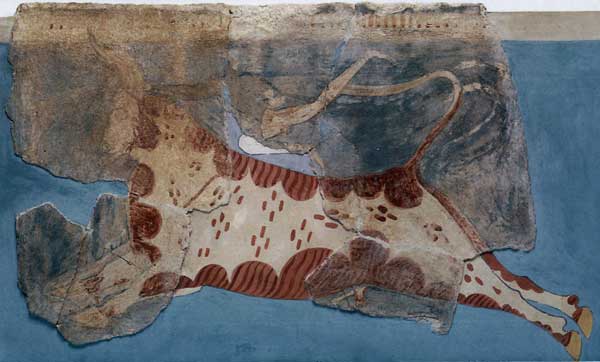
Bull Leaping Scene. Tiryns
The gods of the Indo-Europeans, on the other hand were associated with the sky and were much more mobile. The goddess was primarily concerned with fertility—the fertility of the earth, of the wildlife and of the people. She was also the goddess of hearth and home, the humanity’s attempt to impose some kind of permanence on their cosmos. These concerns did not suddenly end with the arrival of the newcomers and goddess worship was immensely important throughout ancient times. The Eleusinian Mysteries, which celebrated the cult of Demeter and Persephone with ecstatic rituals, were much more popular than the worship of the Olympians and continued to be so until the Christians made it illegal. Also of fundamental importance in later times was the cult 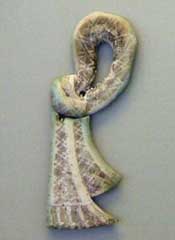 of Hestia (or Vesta, as she was known to the Romans), the goddess of the hearth. The central feature of all of the known Mycenaean palaces is a great hearth and it is difficult not to see it in this connection.
of Hestia (or Vesta, as she was known to the Romans), the goddess of the hearth. The central feature of all of the known Mycenaean palaces is a great hearth and it is difficult not to see it in this connection.
The shaft graves at Mycenae—especially, Circle A—contained a wealth of jewellery, clothing ornaments and other small objects. Minoan religious symbols such as the labrys (double-axe), the sacral knot (left) and the ‘horns of consecration’ are fairly common. The iconography is predominantly feminine. Goddesses are depicted much more frequently than gods and in most instances are the main focus of attention. That does not necessarily mean that Minoan religion was matriarchal, perhaps it is just that the feminine side of it is more visible in the surviving evidence. Many of the scenes appear to be ecstatic and visionary with drugs and dancing clearly in evidence. It is difficult not to think in terms of orgiastic Dionysian rituals accompanying the sacred marriage of the god and goddess, the sacrifice of the god at harvest time and his rebirth in the spring.
Gold Signet Rings from Mycenae
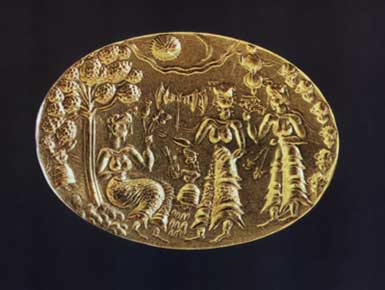
The scene depicts a goddess seated beneath a fruit-laden tree, holding what appear to be poppies in her hand and receiving floral offerings from female devotees. Hovering between them is a labrys or double axe, an instrument of sacrifice and a powerful symbol of the goddess.
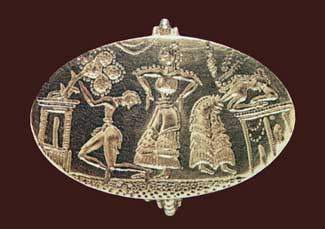
The central figure is probably a priestess and seems to be dancing. She is looking at a young man, clad only in a short kilt, who is clasping a tree as his legs buckle beneath him. Behind her, another priestess is resting her head on an altar and sobbing.
The Cult Centre
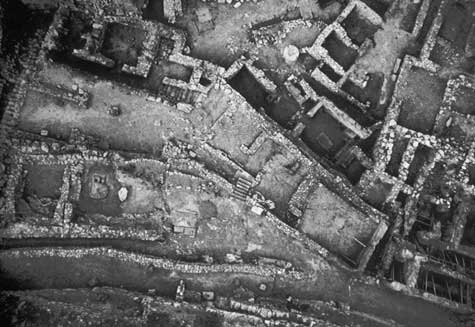
Aerial of the Cult Centre at Mycenae with the Tsountas House to the left
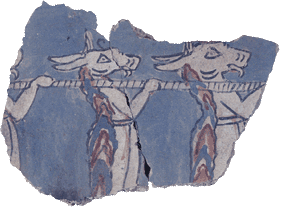 To the south of Grave Circle A is an area known as the Cult Centre which is linked by a circuitous processional way from the palace on the summit (the red arrows in the plan, opposite). At the bottom of the hill it makes a sharp turn and leads directly to a large megaron known as the Tsountas House. There is a plastered square altar in the forecourt of the adjacent building to the northeast and, within it, a horseshoe-shaped fixture with traces of burning and a rectangular block which may have served as a slaughtering stone. Fragments of painted wall plaster were found within the Tsountas house and the building on the other (southwest) side, including one showing a procession of asses. A plaster tablet shows two women who appear to be priestesses on either side of an altar and the so-called ‘shield goddess’. The latter was presumably the deity who watched All of this is pretty clear evidence of a religious function for the buildings.
To the south of Grave Circle A is an area known as the Cult Centre which is linked by a circuitous processional way from the palace on the summit (the red arrows in the plan, opposite). At the bottom of the hill it makes a sharp turn and leads directly to a large megaron known as the Tsountas House. There is a plastered square altar in the forecourt of the adjacent building to the northeast and, within it, a horseshoe-shaped fixture with traces of burning and a rectangular block which may have served as a slaughtering stone. Fragments of painted wall plaster were found within the Tsountas house and the building on the other (southwest) side, including one showing a procession of asses. A plaster tablet shows two women who appear to be priestesses on either side of an altar and the so-called ‘shield goddess’. The latter was presumably the deity who watched All of this is pretty clear evidence of a religious function for the buildings.
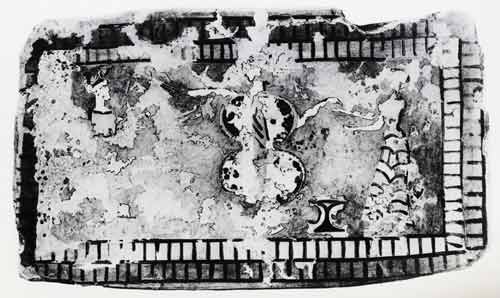
Painted Plaster tablet showing two women flanking the ‘Shield Goddess’
To the northwest, at a lower level, is an open area with a circular altar associated with deposits of ashes, potsherds and animal bones. Next to it is a small building known as the House of Idols, consisting of a large oblong room with a vestibule and a small annex at the rear. The main room has a central, plastered dais (no trace of burning) and a row of narrow platforms of varying heights at the back end. Atop the highest, hidden behind a pillar, was a clay statuette of a goddess with an offering table before her. In the northwest corner, a window opened onto an outcrop of bare rock-screened from outside view by a diagonal cross wall. This suggests the deities involved were of the earth and underworld.
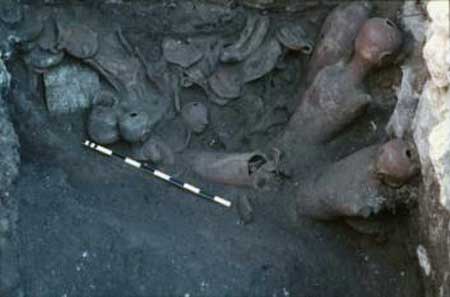
Annex of the House with the Idols (as excavated)
Behind a screen (?) of 3 columns, a flight of steps led to a small room containing a number of broken idols, clay snakes, offering tables and pottery. There were both male and female deities, perhaps representing a pantheon, which may have sat on the other staggered platforms in the main hall.
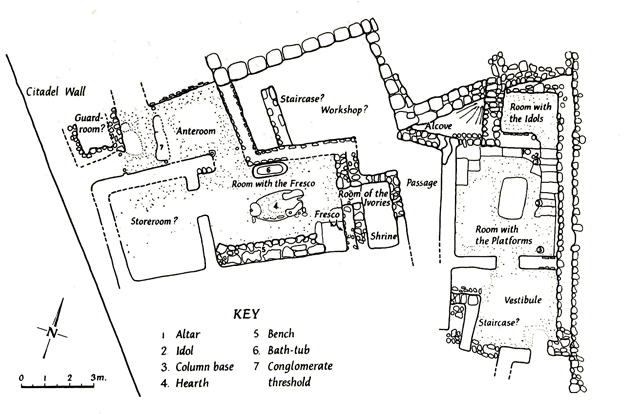
Plan of the Cult Buildings
Another shrine, the House of Frescoes, lay next door, to the west. The layout was somewhat different— an anteroom led to a rectangular main hall with a central oblong hearth. Against one long wall was a clay larnax (it looks much like an old fashioned bath tub) while a bench ran along the wall opposite. At the end of the bench was a square altar with frescoes on its face and on the wall above. Fragments of a presentation scene-goddesses seated and standing with spear and sword. Horns of consecration were depicted along with a seated goddess and a priestess carrying what appear to be sheaves of wheat in her hands. A small annex to the southeast was probably a shrine. A terracotta idol was found there along with glass beads and pottery.
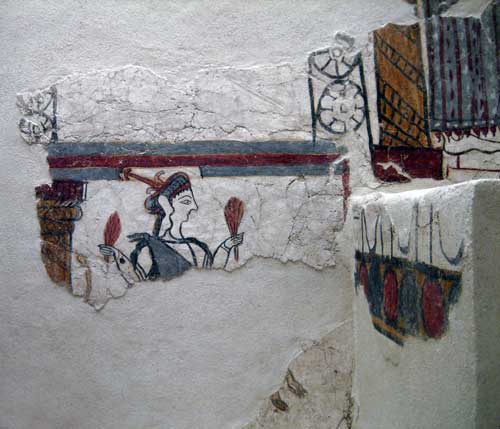
House of Frescoes. Presentation Scene (photo by AlMare)

